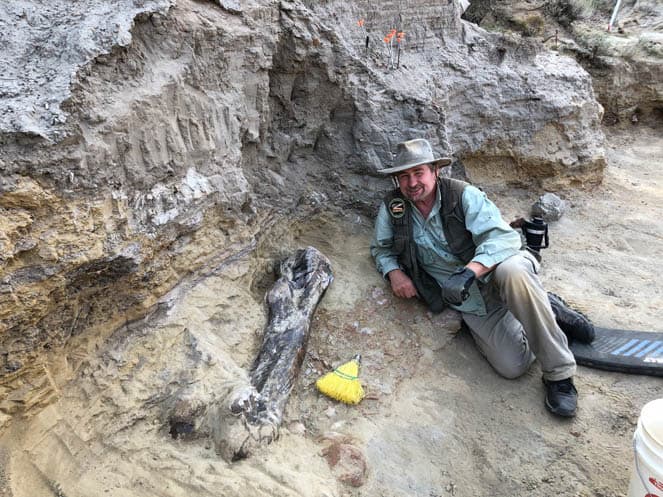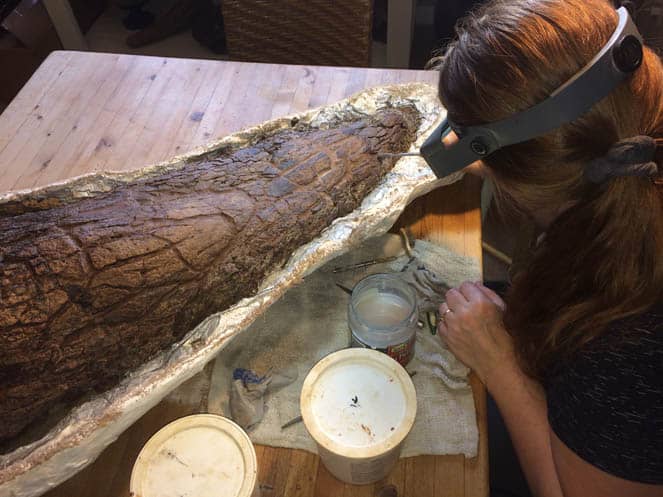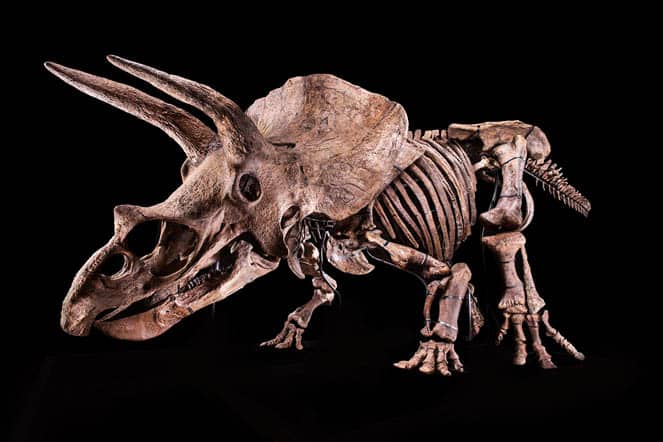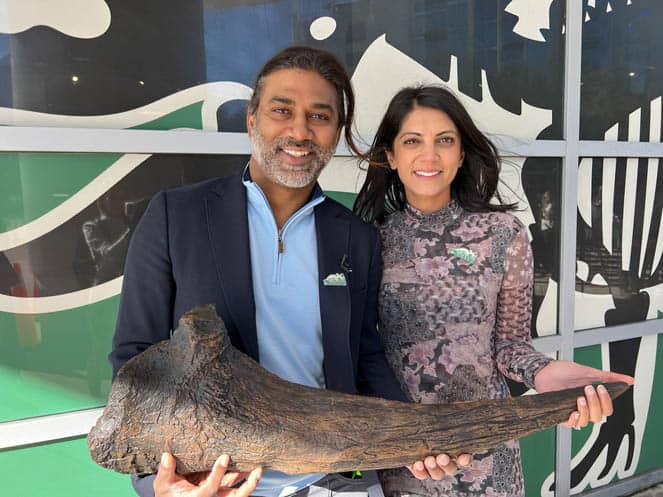Meet the People Bringing ‘Big John’ the Triceratops to Tampa
Big John the Triceratops has been on quite the worldwide tour since he was first discovered in South Dakota's Hell Creek Formation in 2014.
It took almost two years to get him out of the ground. TWO years, y'all. After that arduous process, the world's largest fossil triceratops made his way to Italy where he was removed from the plaster molds that secured his delicate fossils and was painstakingly restored.
With his fossilized bones back in place, the colossal dinosaur was displayed in Italy for the public to see and put up for sale and then, it was off to Paris where he was displayed once again and auctioned off in 2021 to a mystery buyer.
And we all wanted to know…WHO bought Big John the Triceratops and what would become of this record-breaking fossil? Would we ever see him again?
Friends…that cloak of mystery has been removed. We now know WHO bought Big John the Triceratops and HOW he ended up here in Tampa, where he is now on display at Glazer Children's Museum.
And it all started with a little boy's BIG passion for dinosaurs.
So, let's get to it! Here is Big John's spectacular journey to Tampa Bay which was 66 million years in the making.
The man who found Big John the Triceratops: Walter Stein

Walter Stein knows fossils. A paleontologist who co-owns PaleoAdventures with his wife Heather, Stein has worked on more than 30 important dinosaur fossil skeletons, written two books, and serves on the board of directors for the Association of Applied Paleontological Sciences (AAPS). And that's just the tip of his iceberg of credentials.
Every year, he sets out on the vast Hell Creek Formation in search of his next big discovery and in 2014, he found his way to a private ranch owned by rancher John Weiner.
About the Hell Creek Formation: “The Hell Creek Formation is the late Cretaceous period, so you're looking at about 66-67 million years old. It's the final rock unit in the United States prior to the Big Extinction event in the K-Pg Boundary where all the dinosaurs go extinct.” -Walter Stein. It covers parts of Montana, Wyoming, North Dakota, and South Dakota.
The fact Big John was found at all is a miracle according to Stein. While finding a triceratops or other dinosaur fossil in the Hell Creek formation isn't super rare, “I once did a calculation that there are over 260 million cubic kilometers of material still left buried in the ground,” he told us. “So when folks tell you that dinosaurs are rare, that’s not entirely the case—there are lots of dinosaur bones out there, the trick is finding the good skeletons and the only way to do that is by looking.”
The hard part is getting permission to search for those bones on private property and gaining the trust of landowners.
“They’ve either had commercial types out there in the past that have ripped stuff out of the ground and don’t care about the science, and then there are times they’ve had academics out there who have actually trespassed or even worse suggested they can confiscate their ground in the name of science,” Stein explained.
There’s no positive incentive to be let out there he said, but John Weiner said yes. And it turns out, Stein was the first to ask him. In fact, Big John is named after Weiner.
Finding Big John the Triceratops
During one of his outings on Weiner's property in 2014, Stein noticed something coming up from under the ground and knew right away it was a piece of a triceratops horn.
“It was like, okay, we’ve got a triceratops and then— boy…this thing has been sitting out weathering for a long time, there’s a big field of fragments. It was fairly complete, so we dig in and find out what’s left and when we saw the base of the horn, that thing was as big around as a tree trunk. It’s huge and I’m like this is going to be a very big dinosaur,” Stein told us.
His instincts were right on. The fossil he discovered became the world's largest triceratops fossil found to date, measuring at 26 feet long and nearly 10 feet high. The skull is also huge, at more than five feet long.

Stein tells us it took his team two seasons to get Big John fully out of the ground. It seems that digging up dinosaurs is about as hard as getting permission to do it in the first place.
“Digging up dinosaur bones is a ton of work,” said Stein. “You’re out there in a 100-some degree temperatures, blazing sun, the South Dakota winds are always blowing and beating you in the face, sand blowing your eyes. These bones are not light, that horn weighs quite a bit, so you’re muscling this stuff up out of the Badlands trying to get this back to the lab.”
Big John's next adventure: Reconstruction
Stein says they knew they didn't have the capacity to hold onto the skeleton or a place to display it. He also knew they couldn't hold onto it infinitely, so they sold it to the Italian company Zoic.
The team at Zoic restored Big John, but several pieces of the skeleton were missing. Stein explains why and takes us back 66 million years.
“It would not have looked like South Dakota. Back 66 million years ago it would have looked more like this, more like Florida. Lots of swamps and estuaries, and meandering river systems going across the prairie. The ancestral early Rocky Mountains were pushing their way upwards. These rivers would have been draining from those early Rocky Mountains and every time one of those rivers would flood, it would dump 5-10 feet of mud out there in the flood plains,” Stein told us. “So anything that was dead out there was getting buried in the mud had a chance to get preserved and fossilized.”
That's what happened to Big John. Only he was pretty big, so he didn't get completely buried in mud.
“The bones that were buried in that mudstone got squeezed and compressed and that mudstone actually preserved the bones really well, so the parts of the right side, the right denture, the right arm, the scapula, those are really in phenomenal shape. But the whole thing wasn’t buried. Parts of it were sticking up out of the sand 66 million years ago. So it took maybe a few months, but then there was another flooding event that came and buried it with sand and another one with mud. Because there was mud on the top and mud on the bottom, the things that were in the mud preserved well.”
Estimates vary, but Stein says about 40% percent of his skeleton remained and 60-70% of his skull.
“This is actually pretty good. Most skeletons are about 20%,” said Stein.
The rest had to be cast to fill in the missing areas to complete Big John.
Big John goes to auction

Zoic displayed Big John in Italy and he was put up for auction and purchased by a mystery buyer in 2021. The news was a bit rattling for Stein and his team.
“I was like, (sigh) this could go wrong, this could go bad. I was a little nervous to be perfectly honest,” he told us. “The whole scientific community and my colleagues were like where’s Big John? Where did Big John go? We hope it’s not in somebody’s living room or decorating a pool. We wanted this specimen from day one, we wanted it to be in a museum.”
This is where a Tampa family's story picks up on Big John's journey to Tampa…
Who Bought Big John the Triceratops? The Pagidipati Family

Sidd Pagidipati of Tampa has had a lifelong admiration for dinosaurs that began when he was a little boy on a road trip with his dad and siblings.
“After my third-grade year—I was a mediocre student, I wasn’t really that curious or interested in the textbooks. My dad took us on a road trip,” he told us. “We happened to swing through the Natural History Museum in New York and also the Smithsonian [in Washington DC] and once we walked in, my brother, sister, and I…our eyes lit up. We got a sense of all of –these things that were in our textbooks came to life. Our interest in science and animals became deeply passionate.”
Fast forward a few decades and he's now a successful businessman in Tampa, a husband to Ami and a father of two little kids who share his interest in dinosaurs. A friend sends him a CNN news article about Big John the Triceratops going to auction.
“My passion for dinosaurs gave me the courage to ask my wife Ami, ‘Hey babe—what do you think of buying a dinosaur and bringing it to Tampa Bay?' After a couple of weird looks and are you crazy, she said maybe and I took that for a yes,” he smiled.
Pagidipati won the auction, purchasing Big John for a whopping $7.7 million. But, they didn't want to keep Big John to themselves.
“When we first purchased Big John, a lot of people were worried he was going to end up in some sort of private collection and from before the moment we bought the item, we knew that we wanted to bring it to Tampa Bay. A lot of museums were vying to take and display Big John and we said, you know what…we want it to be here in Tampa. We want to inspire the thousands of families here to activate their interest in science,” he told us. “We want to do our small part in making Tampa Bay the best place to raise a family in America.”
They decided on Glazer Children's Museum as the perfect spot for Big John to go on display.
“You know—the Glazers are an incredible family and first and foremost, they were the most excited and saw the potential for creating an interactive exhibit and were willing to make the investment in this partnership,” said Pagidipati.
Even though Big John has been on public display twice, once in Italy and once in Paris, he's never seen the full fossil in person.
“Ami and I are so excited for that day when we can see Big John put together. This is going to be a really, really special day for us and our kids …we know they are not going to be able to sleep the night before,” he said with a smile.
“I want to thank my wife for letting me buy a dinosaur,” he laughed.
We're pretty thankful she said yes too…
Big John the Triceratops NOW on display at Glazer Children's Museum in Tampa
Big John officially went on display on May 26, leaving kids and adults in wonder and awe, including Sidd.
“I've been to see this exhibit at least a dozen times and every time I walk through this entrance, I get goosebumps. As a 47-year-old to come and feel like a 5-year-old every time I walk in here and see the aw of what used to be has been amazing,” said Sidd, before giving the museum's CEO Sarah Cole a hug, thanking her and her team for bringing the exhibit to life.
“When you walk through this whole hallway and experience, it's beyond my wildest dreams, so thank you for making my dream come true,” he told her.
You can read more here about the Big John Triceratops exhibit at Glazer Children's Museum.
An exhibit of this magnitude is a dream come true for Cole and her team too. They've built an exhibit that is more than just a display, but an immersive experience built for people of all ages.
“You’re going to be able to come right up close, come up on the sides,” explained Cole. “We’re using lights, we’re using sounds, we’re surrounding it with foliage so it will feel like —he’s going to feel real in that space even though it’s a skeleton. It’s going to feel like a living, breathing thing.”
The official announcement that Big John was coming to Glazer Children's Museum was a huge moment for Cole, even though her team has been keeping it under wraps for the last nine months as they planned the build-out of the exhibit.
“This is the most exciting moment of my career right here. The only thing that has been more exciting was opening this building when we first opened it. It is on par with that for me,” she told us.
Stein was pretty excited too. Fun little tidbit–before the initial sale of Big John, he was able to bring a few of the fossilized pieces to Florida for a presentation to the Tampa Fossil Club, so Big John's arrival in Tampa is kinda sorta a return.
“When we realized it was coming to the Glazer Children’s Museum, I smiled for 24 hours straight. I was very happy it came back to Tampa it came back to Florida,” said Stein. “To be in a children’s museum is even better. Yes, scientists can still come and study it and yes, scientists can still come and visit it, but more importantly, this is going to be an exhibit geared toward kids. This is for the next generation of paleontologists and I’m hoping that will inspire a whole new fleet of paleontologists just like these kinds of bones did when I was a kid.”
Glazer Children's Museum has kids of all ages in mind. They'll be lifting the requirement to have a child under the age of 18 with you in order to go to the museum so everyone has a chance to experience Big John up close and personal.
“I think that as a society, we always think that playing is for kids. But we all play, especially in learning. That’s one of the ways we play, we watch Discovery Channel or we do puzzles or we get lost in a rabbit hole on the internet—all of that is playful learning. We're really intentionally creating this space to allow all of those different times of learning and engagement to happen,” she said of the new exhibit.
The Big John exhibit is NOW OPEN at Glazer Children's Museum and will be on display for at least three years. Learn more at BigJohnDino.com.

